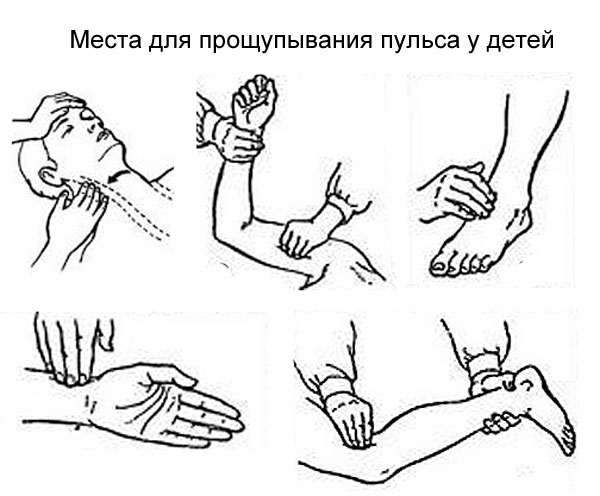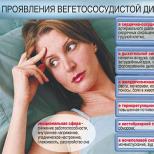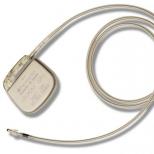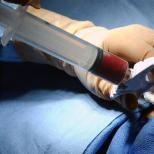Pulse in children: a table of norms by age, when to see a doctor
Article publication date: 03/04/2017
Article last updated: 12/18/2018
From this article you will learn: what is the normal heart rate for children according to their age, in what states the pulse slows down or quickens, how to determine the heart rate.
Heart rate (HR) is the number of heart beats per minute. The definition of this indicator provides important information to doctors about the state of human health.
Normal heart rate on an ECG in an adult
Due to the anatomical and physiological characteristics of the body, in children, the normal heart rate is higher than the norm in adults. The smaller the baby, the higher the heart rate. As they grow older, the rate of heart rate in children gradually decreases, reaching normal values for an adult. Also, children's heart rate is highly dependent on age, stress level and physical activity.
Sometimes babies can also develop heart rhythm disturbances, manifested by irregularity, increased or decreased heart rate. To assess the danger of these conditions, you need to know the rate of heart rate in children of different ages.
Problems associated with abnormal heart rate in children are dealt with by pediatricians and pediatric cardiologists.
Normal heart rate in children
The table will give an idea of the heart rate by age.
In most children and adults, the heart rhythm is regular, that is, when determining the pulse, rhythmic beats are felt with different intervals of time between them. However, in children, a respiratory arrhythmia is quite common, during which the frequency of contractions increases during inhalation and decreases during exhalation. As they grow older, this phenomenon disappears. The exact cause of respiratory arrhythmia is unknown, but its occurrence is associated with a close relationship between the respiratory and cardiovascular systems. Such a violation of the children's heart rhythm is a physiological norm, therefore, no treatment is required.

How to calculate heart rate in a child?
To determine the heart rate, you need a watch with a second hand or a stopwatch on your phone. If the baby was active immediately before the measurement (running, jumping, crying), you need to wait at least 5 minutes, since this time is needed to normalize the heart rate. To feel the pulsation, you need to press two fingers - index and middle - to the baby's large artery. The thumb should not be used for this, as the pulsation of the measurer's own arteries may be mistaken for a pulse.
Places where it is easiest for children to find a pulse:
- On the neck (on the carotid artery). The carotid arteries run on both sides of the neck, on the sides of the larynx. To find them, place your fingers in the middle of the neck, to the left or right of the larynx, and gently press until a pulsation is felt. You can not click on the Adam's apple in boys. If you can't find a pulse, try it on the other side of your neck.
- On the wrist (on the radial artery). At this point, heart rate is measured in most adults. Place your fingers at the base of your baby's thumb and move them toward the wrist, where you press lightly until you feel a pulse.
- In the armpits (on the axillary artery). Place your fingers under the armpit so that you can feel the baby's humerus underneath them. At the same time, it is also possible to feel the pulsation of the axillary artery. This method has proven itself well for determining heart rate in infants.
- In the elbow (on the brachial artery). This heart rate measurement site is most commonly used in infants. Position the baby on his back with an outstretched arm along the body, upward with the elbow crease. In this crease, place your fingers on the inside of the baby's arm and feel for the pulse.

If this method of determining heart rate is very difficult for parents, there is another option. There are smartphone apps that can detect your heart rate. To do this, you just need to press the baby's finger to the camera lens.
When to see a doctor?
If the heart rate is within the age norm, there is no need to seek medical help. There is also no particular cause for concern if the pulse readings are not very much outside the normal range. For example, rapid heartbeats can be explained by activity (running, jumping) or fear. An unexpressed slowing of the pulse can be observed in children involved in sports.
If the baby's heart is beating too fast, you need to wait a few minutes and count the pulse again. If the results are still outside the age range, you should consult a doctor.
If, in addition to an increased or decreased heart rate, other symptoms are observed (fainting, shortness of breath, chest pain), it is urgent to seek medical help - call an ambulance or take the baby to the emergency room.
When do you need to monitor the pulse in children?
It is usually not necessary to count the heart rate in healthy children. But there are diseases in which parents have to regularly determine the heart rate of the baby. It is necessary to consider the heart rate if he complains of an accelerated heartbeat, a feeling of interruptions in the work of the heart. Some children describe a feeling of buzzing, vibration, or fluttering in the chest. Most often, these sensations are not something serious and are not connected with the heart at all. Pain or spasms in the muscles of the neck or chest can lead to their appearance. However, in such situations it is still necessary.
It is also necessary to determine the heart rate in children in the following situations:
- fainting;
- chest pain;
- breathing problems not related to asthma
- sudden onset of pale or gray skin;
- blue lip color.





